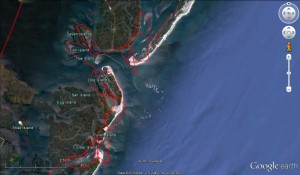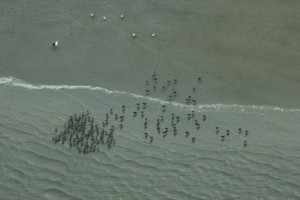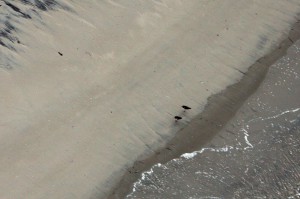Oystercatcher Project in Flight
Surveying American Oystercatchers from the Sky
By Stephanie Egger, Wildlife Biologist

If you happened to be taking a stroll on a chilly February afternoon on the beaches of New Jersey and you saw a blue and white Cessna in the sky flying in a not-so-straight pattern, well that was me in the back of the teeny 4-seater plane. Last Tuesday I helped complete the New Jersey segment of the American oystercatcher winter survey, which is being directed by Shiloh Schulte from the Manomet Center for Conservation Sciences, in partnership with the American Oystercatcher Working Group. Other staff from the Conserve Wildlife Foundation of New Jersey and the State’s Endangered and Nongame Species Program were on the beach (or in a boat) “ground-truthing” the survey in order to verify the data that were collected during the flight.

After swallowing a motion sickness pill as a precautionary measure (thanks Shiloh!) our four hour flight took off early afternoon from the Cape May County Airport, starting with a survey of Cape May Inlet. We continued our flight north, surveying Hereford, Townsend’s, Corson’s, Great Egg Harbor, Absecon, Brigantine, Little Egg, Barnegat, and Manasquan Inlets and finally Sandy Hook Gateway National Recreation Area. We saw flocks of wintering oystercatchers, from a handful to up to 140 birds, using sand and marsh habitats. It was quite the first-time experience for me. Surveying from the air is NOT the easiest, but especially if a flock is seen at the last second and the plane has to bank hard. I admit I even glanced around for a sick bag a few times, but stayed strong! I don’t get seasick or airsick, but flying in a Cessna and doing numerous turns and banking was a whole new feeling. There were many times all I could see from the backseat was water with no horizon to focus on, all while attempting to take good photographs of the flocks for the count. Try doing that when you are sideways! In the end I managed to do really well at both, taking photos of the flocks and not getting sick during my aerial survey. Go me!

Now onto the important stuff – the results. A preliminary total of about 242 oystercatchers were counted on this aerial survey compared to 973 during the 2002-3 range-wide aerial “winter” survey. As expected, flocks were only found in the southern portion of New Jersey (Hereford to Little Egg Inlets), with the most birds being located in Absecon Inlet. Although the total number of oystercatchers tallied on this survey was significantly less than the previous one, it does not concern us from a conservation perspective as the earlier survey was conducted in late November. Based on extensive fall and winter surveys we have conducted within the state over the past decade, we know our wintering population falls off sharply in the late winter as cold weather sets in and food resources are more limited. The purpose of this survey was to complete a range-wide population assessment so those birds no longer in New Jersey during this survey window would have been detected in other states, likely further south. The Atlantic Coast from Jones Inlet, Long Island, New York to Florida and the Gulf Coast from Florida to Texas was flown as part of this survey.

In the end, it was a great opportunity for me to gain experience in aerial surveys of oystercatchers. Besides being an exhilarating flight (buzzing by my coworkers at 130 mph), I have to add it was really beautiful up there. Seeing many other species of birds utilizing the beaches and marshes in the winter, mostly free from boat traffic or other disturbance was very peaceful. The experience re-invigorated my soul to continue working even harder for the conservation of American oystercatchers and other protected species in New Jersey and beyond.
Discover more from Conserve Wildlife Foundation of NJ
Subscribe to get the latest posts sent to your email.
Leave a Comment
Great account Stephanie, and fantastic work up there! Glad you came. 🙂
Thanks Shiloh! It was a great trip!
Awesome Job Stephanie!!! What an amazing experience!!!!! Jealous!!!!
Great article too!!!!!
Thank you Tina for the great comments!
Awesome…great article. How nice to be able to do work that you enjoy,
and at the same time help Mother Earth!
I agree with Shiloh; the way you wrote the article made me feel like I was there.
As usual, I am very proud of you.
Comments are closed.